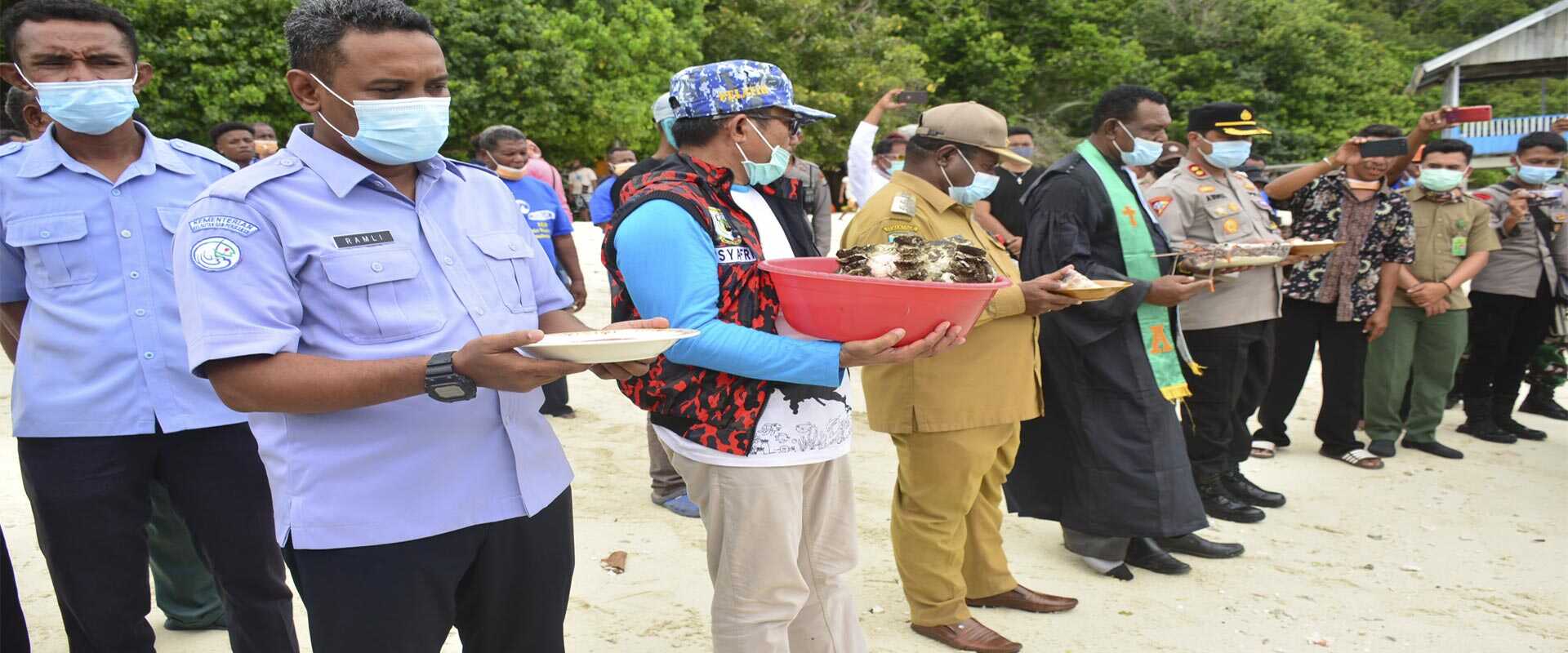Indigenous Community Strengthen Natural Resources In Wayag With Sasi And Customary Regulation-Reported by: Bertha Matatar* & Rens Lewerissa* Written by: Nikka Gunadharma***
INDIGENOUS COMMUNITY STRENGTHEN NATURAL RESOURCES IN WAYAG
WITH SASI AND CUSTOMARY REGULATION
Reported by: Bertha Matatar* & Rens Lewerissa** Written by: Nikka Gunadharma***
The abundance of Raja Ampat’s natural resources makes it one of the primary livelihoods for the local communities, be it fisheries or tourism activities, that should be preserved and managed properly so that the benefits would be sustainable.
On the other hand, the abundance in natural resources within this archipelagic regency is, indeed, magnets to various, destructive utilization practices that, according to the routine patrol conducted by the rangers from Raja Ampat Marine Park Authority, mostly done by people beyond Raja Ampat.
In that context, indigenous community of Kawe from Selpele and Salio villages, which customary territory happens to be part of the West Waigeo Islands Marine Reserve, have reached a consensus to organize Sasi ceremony for marine biotas such as sea cucumber, sea snail, lobster, giant clams, and turtle.
Sasi can be interpreted as customary prohibition in utilizing particular natural resources as part of the effort to preserve natural resources that aims to preserve the quality and the population of that particular natural resources.
The West Waigeo Islands Marine Reserve was officially under the management of Ministry of Marine and Fisheries’ Raja Ampat Work Unit, and with technical support from the Raja Ampat’s Marine Park Authority.
Marten Ayelo, one of the Kawe community’s figures, explained that many people from beyond Raja Ampat have come and taken marine resources in Wayag. Prior to this, it has been two times that the Kawe community had applied Sasi in Wayag. When asked about the expectation from the community related to this latest Sasi Marten conveyed, “We want better crops from our sea.”
The procession took place in Wayag Ranger’s Monitoring Post on the 03rd of November 2020, and was inaugurated by Manuel Piter Urbinas as the Acting Regent of Raja Ampat, and the Chief of the Raja Ampat’s Maya Tribe Customary Council, Kristian Thebu. The Head of Raja Ampat’s Evangelical Church in Papua, Reverend Cristofel Padwa, then presided a brief prayer before the Sasi ceremony took place.
Sasi ceremony begun as Manuel Piter Urbinas, Rev. Cristofel Padwa, the Head of Raja Ampat’s Marine Park Authority,and the Head of Raja Ampat’s Work Unit from the Ministry of Marine and Fisheries symbolically released sea cucumber, sea snail, lobster, and giant clams to the sea. While Adjunct Chief Commissioner of Police Andre JW. Manuputty, the Head of Raja Ampat’s Police Resort, buried turtle’s eggs as a symbol of Sasi.
The procession was further confirmed with the signing of minutes document related to Sasi by the village chiefs, customary community’s figures, and religious’ figures from both Selpele and Salio villages. Besides the Sasi ceremony, another highlight from the event was the launch of Raja Ampat’s Maya Tribe Council Customary Regulation on the Protection of Wayag and Surrounding Islands Including the Ecosystem of Biotas Within It.
Kristian Thebu explained that this Customary Regulation aim to strengthened the Sasi conducted by the communities in Selpele and Salio villages, and as basis for them to take customary actions toward violations conducted in Wayag and the surrounding area. The Customary Regulation will also help the community-based ranger patrols within the West Waigeo Islands Marine Reserve.
“Violators in Wayag and the surrounding area will be processed through customary session held in the village by the Three Furnaces – customary, religious, and village institutions. We will do similar thing (the development of Customary Regulation) for the northern waters of Misool Islands,” Kristian explained.
The Head of Raja Ampat’s Work Unit, M. Ramli Firman, ST., MT. stated, “On behalf of the Ministry of Marine and Fisheries’ Director General of Marine Spatial Management, we warmly welcome this community’s initiative. The community is, indeed, the spearhead of all of this, while we will keep doing mentoring and conduct supervision efforts based on the regulations.”
The Head of Raja Ampat’s Marine Park Authority, Syafri Tuharea, S.Pi. appreciates that the Sasi and Customary Regulation is of strategic value and in alignment with the government’s intention. Syafri also emphasized the importance of the Customary Regulation in the context of supervision and law enforcement activities, “It is a part of the system to prevent crime of fisheries. Things that are not covered in conventional laws and other regulations will be enriched through this Customary Regulation.”
In general, the event held in Wayag on the 03rd of November 2020 was attended by no less than one hundred and ninety participants. Besides the parties mentioned above, the event was also attended by representatives from Ministry of Environment and Forestry’s West Papua Natural Resources Conservation Office, Indonesia Teachers Association, Raja Ampat 1805 Military District Commando, Terumbu Karang Indonesia (TERANGI) Foundation, Pusat Informasi Lingkungan Indonesia (PILI) Green Network, Nazaret Papua Foundation, and Fauna & Flora International (FFI) Indonesia.
This event was collaboratively supported by United States Agency for International Development (USAID) through the grant program of Blue Abadi Fund that is funneled to Penyu Papua Foundation, Conservation International (CI) Indonesia, and fully supported by the Ministry of Marine and Fisheries’ Raja Ampat Work Unit, Raja Ampat’s Marine Park Authority, Raja Ampat’s Regency Government, Raja Ampat’s Maya Tribe Customary Council, and members of community from Selpele and Salio villages.
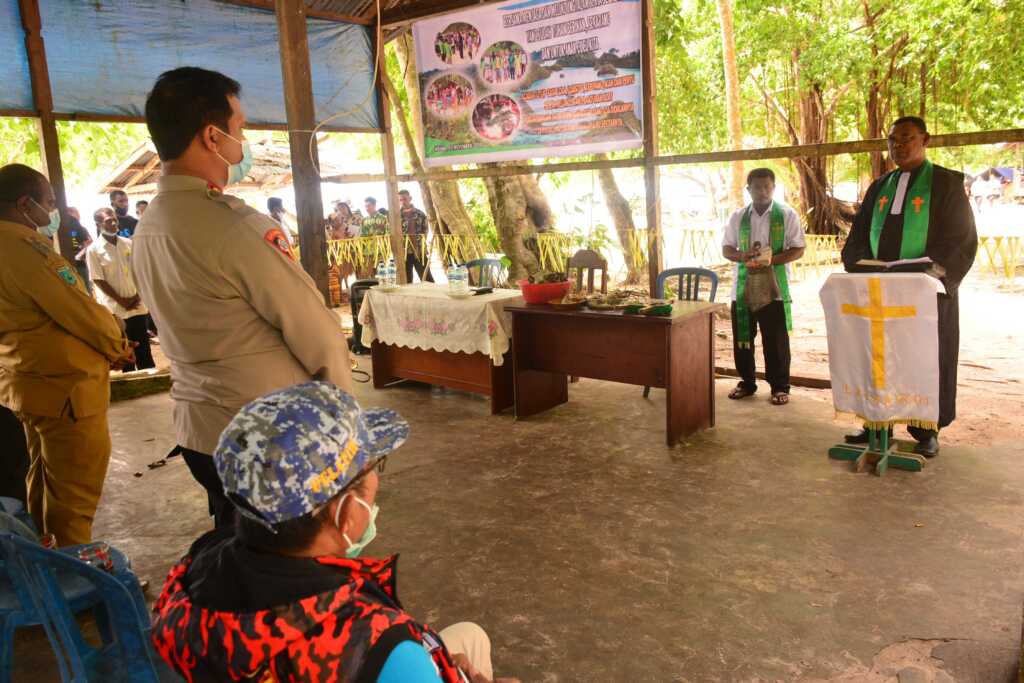
Prayer before the procession of Sasi in Wayag was led by Reverend Cristofel Padwa, the Head of Raja Ampat’s Evangelical Church in Papua. (Photo by: Rens Lewerissa-CI Indonesia/2020).
Ibadah sebelum prosesi tutup sasi di Wayag yang dipimpin oleh Pendeta Cristofel Padwa, Ketua Klasis Raja Ampat GKI di Tanah Papua. (Foto Oleh: Rens Lewerissa-CI Indonesia/2020).
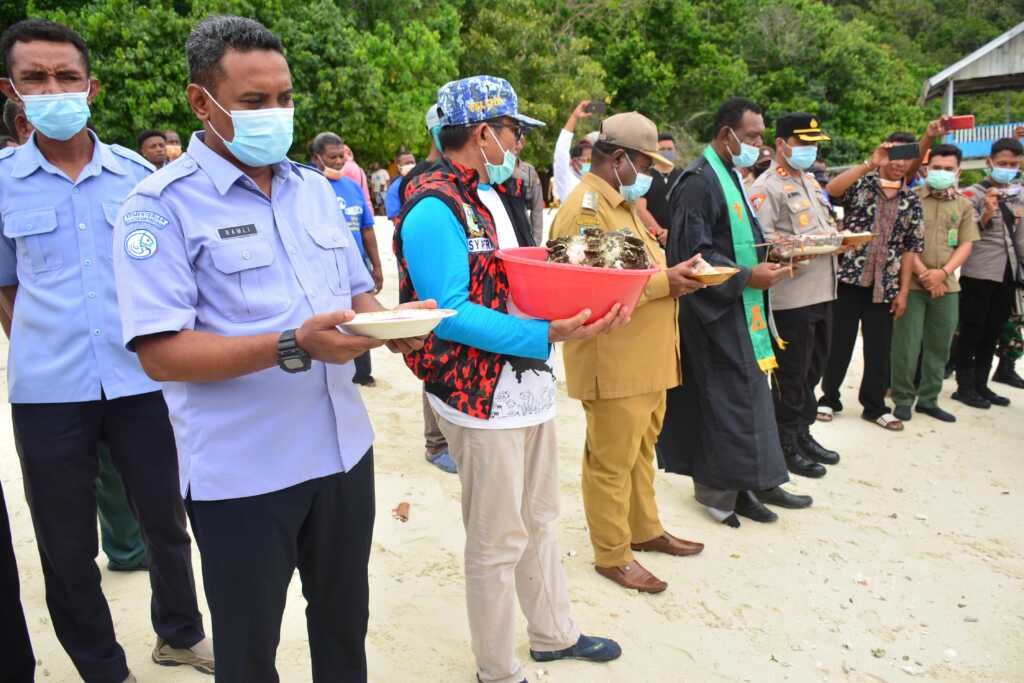
Invitees were releasing several marine biotas that served as Sasi objects in Wayag. (Photo by: Rens Lewerissa-CI Indonesia/2020).
Pelepasan beberapa biota laut yang menjadi objek sasi di Wayag oleh para undangan. (Foto Oleh: Rens Lewerissa-CI Indonesia/2020).
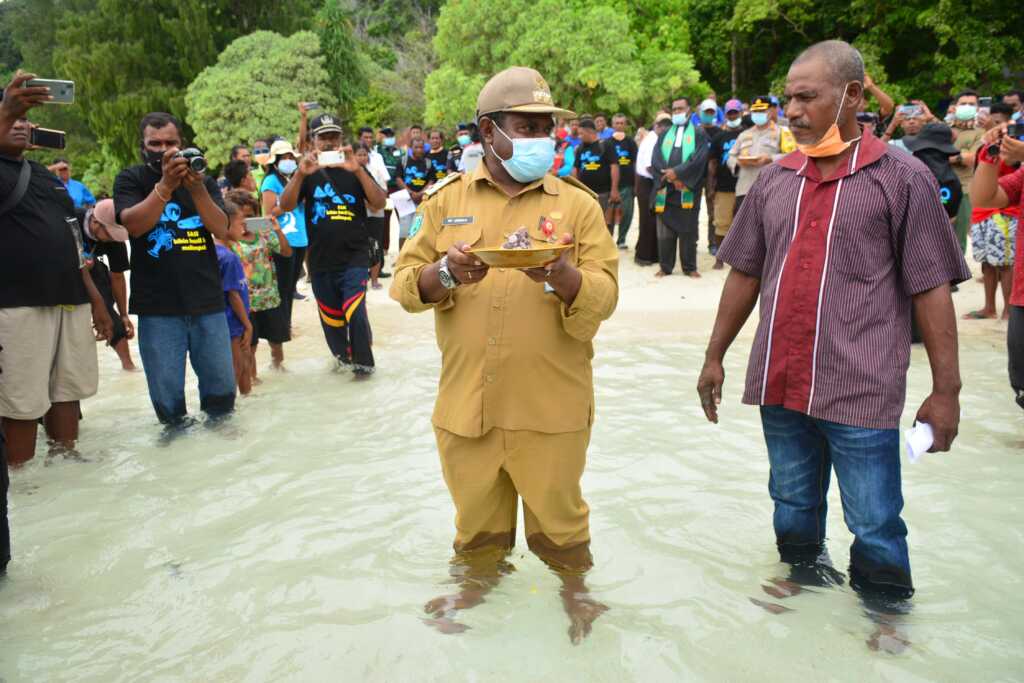
Acting Regent of Raja Ampat, Manuel Piter Urbinas – moments before symbolically releasing one of the marine biotas during the Sasi ceremony in Wayag. (Photo by: Rens Lewerissa-CI Indonesia/2020).
Plt. Bupati Raja Ampat, Manuel Piter Urbinas, sesaat sebelum secara simbolis melepas salah satu biota laut yang akan disasi di Wayag dan perairan sekitarnya. (Foto Oleh: Rens Lewerissa-CI Indonesia/2020).
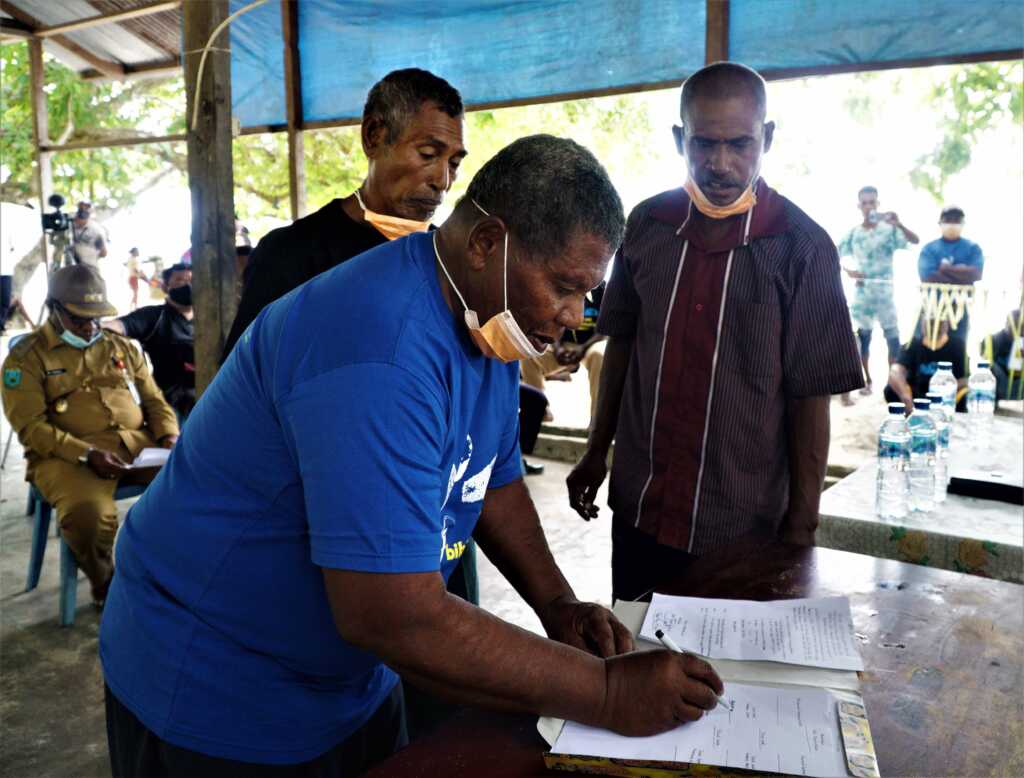
Representatives from Selpele and Salio villages signing the Sasi’s minutes document. (Photo by: Rens Lewerissa-CI Indonesia/2020).
Penandatanganan Berita Acara Sasi oleh perwakilan masyarakat Kampung Selpele dan Salio. (Foto Oleh: Rens Lewerissa-CI Indonesia/2020).
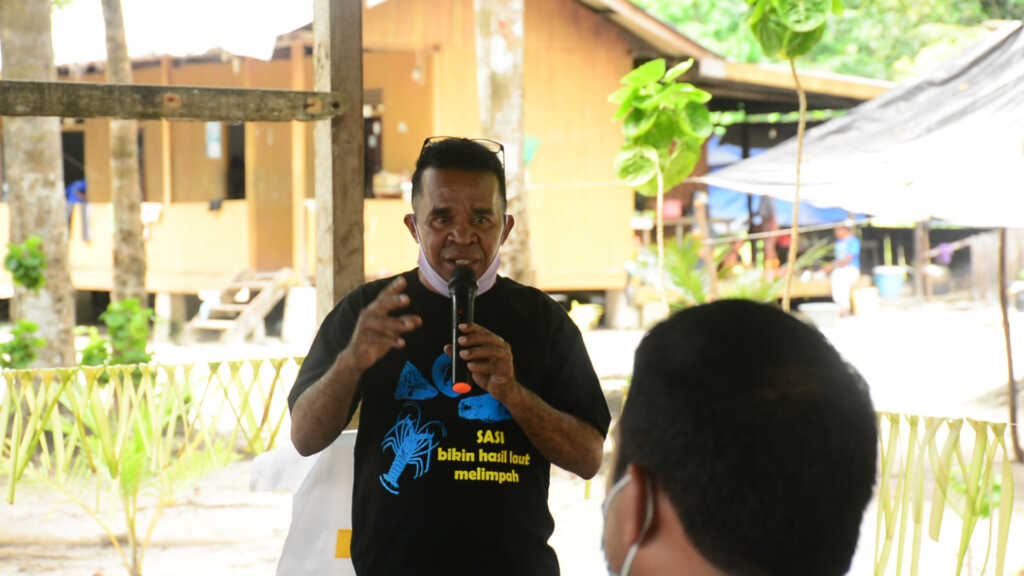
Chief of Raja Ampat’s Maya Tribe Customary Council, Kristian Thebu, gave speech in the inauguration session prior to Sasi procession. (Photo by: Rens Lewerissa-CI Indonesia/2020).
Ketua Dewan Adat Suku (DAS) Maya, Kristian Thebu, memberikan sambutan dalam sesi pembukaan. (Foto Oleh: Rens Lewerissa-CI Indonesia/2020).
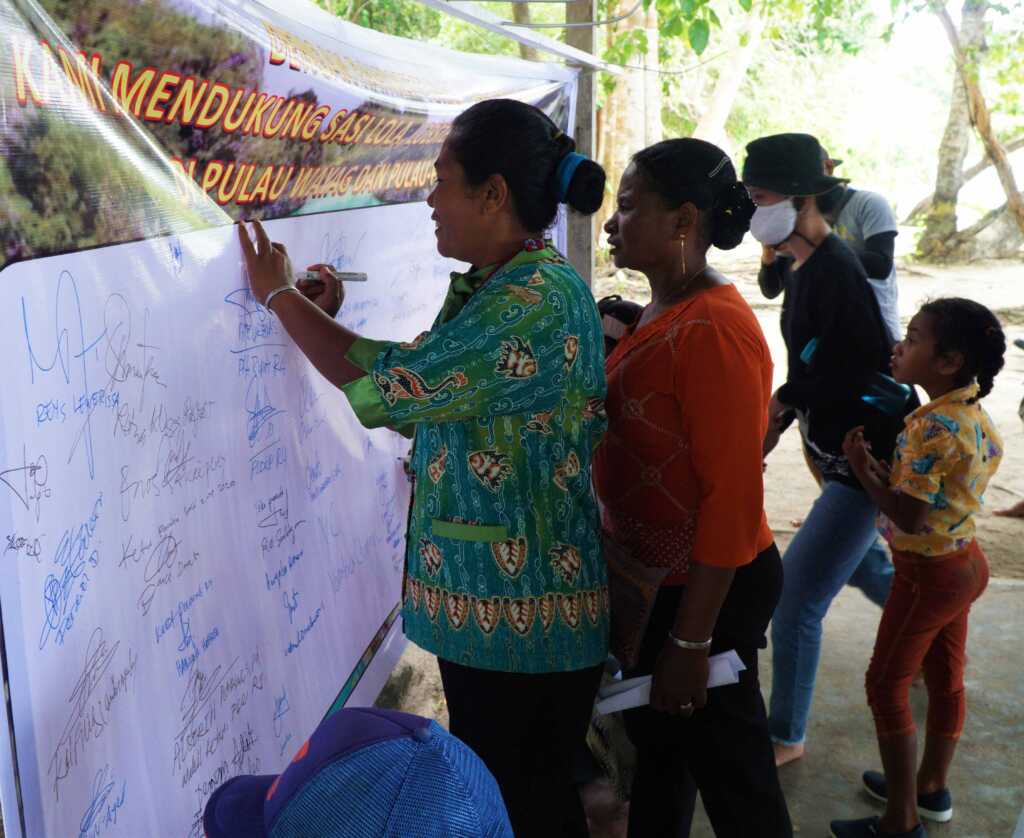
Participants of the event gave their signature in the banner supporting the Sasi initiative and the Customary Regulation to protect the natural resources in Wayag and its surrounding waters. (Photo by: Rens Lewerissa-CI Indonesia/2020
Peserta kegiatan menandatangani spanduk dukungan bagi inisiatif sasi dan berlakunya peraturan adat untuk melindungi sumber daya alam hayati di Wayag dan perairan sekitarnya. (Foto Oleh: Rens Lewerissa-CI Indonesia/2020).
* Bird’s Head Seascape Capacity Building Coordinator for CI Indonesia
** Raja Ampat Communication & Outreach Officer for CI Indonesia
*** Raja Ampat Communication & Outreach Coordinator for CI Indonesia





































